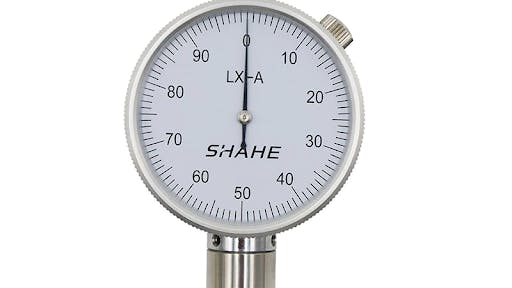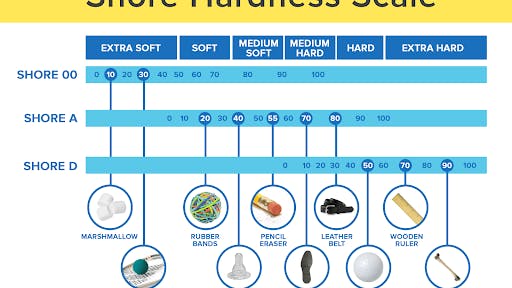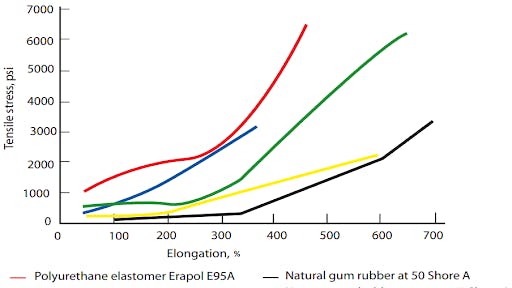
Durometer vs. Elasticity
Durometer hardness is a dimensionless unit of measure used to define the hardness of flexible elastomers or more rigid plastics. This article will explain what it is and the correlation between durometer vs. elasticity.

Durometer vs. Elasticity
Flexible elastomers are widely used in almost every industry. They’re found in products like car tires and sealing gaskets. Specific elastomers are often selected by looking at the material’s hardness or durometer. Another property that often gets quoted is elasticity. Technically, however, the two properties are not linked so there is no specific correlation between durometer vs. elasticity.
This article will explain how durometer hardness is defined and why it cannot be used as the primary parameter in elastomer selection. In the same sense, elasticity cannot be the only factor used to select an elastomer either. In truth, selecting an elastomer is a complex process encompassing several interlinked properties. We will discuss these properties and shed some light on when they can be used.
What is Durometer Hardness?
Durometer hardness is a dimensionless unit of measure used to define the hardness of flexible elastomers or more rigid plastics. It operates in much the same way as the Brinell scale used to measure the hardness of metals. Durometer is often quoted as an important elastomeric material property but is sometimes incorrectly perceived as indicating the material's flexibility and strength. Durometer is also referred to as shore hardness.
Source: Spring Loaded Device
The durometer hardness of an elastomer is measured using a spring-loaded device like the one pictured below. Essentially, the device is pressed into the material and the amount of penetration achieved by the tooltip is converted into a number to define the material’s hardness.
The specific durometer scale determines which measuring tool is necessary. Each style uses differently shaped tips and springs to measure the hardness. In general, harder materials are measured with sharper tips and softer materials with flatter tips.
There are many different durometer hardness scales but the three most common are Shore A, D, and 00. As Figure 1 below indicates, Shore 00 is designed for relatively soft materials and Shore D for much harder ones. A durometer hardness of 10 on the Shore 00 scale is equivalent to the hardness of a marshmallow whereas a durometer hardness of 10 on the D scale is equivalent to shoe-sole rubber (and is near the upper limit of Shore 00). Each scale serves different categories of materials. Shore D can measure the hardness of bone, but not of rubber bands, for example. They all overlap but are tailored to different hardness ranges. Figure 1 illustrates some good reference points.
Figure 1: Shore Hardness Scale
What is Elasticity?
When it comes to elastomers, elasticity refers to the amount of stress a material undergoes to achieve a specific strain as well as its ability to return to an undeformed state. However, unlike metals, there will always be a degree of permanent deformation after a load/unload cycle. This is known as a permanent set. Graphs of elasticity are often presented at 100, 200, and 300 % elongation. Figure 2 shows the stress-strain relationship between different polyurethanes and rubber.
Figure 2: Elastomers Datasheet, Pg. 6
When an elastomer is deformed by a load, its stress-strain curve will be similar to Figure 3 below. The area between the loaded and unloaded curve is equivalent to the energy stored in the material and is a measure of the material’s resilience. Two materials are examined in this figure. The loaded/unloaded curve represented with solid lines has a smaller area between the two lines and is, therefore, more resilient than the material represented with the dotted lines.
Figure 3: Polyurethane Stress Strain (Figure 7.1)
Resilience refers to the ratio of energy return between a load/unload cycle. A perfectly elastic material will release all the energy collected during deformation. However, perfect elasticity does not exist. If a perfectly elastic ball was dropped from a height, it would return to the same height after bouncing off the ground, provided there is no air resistance. In reality, this is not physically possible. Therefore, any time an elastomer undergoes a load/unload cycle, it will retain some portion of that energy in the form of heat or permanent deformation.
High-resilience materials are best when spring-like behavior is desired while low-resilience materials fit applications that need energy to be absorbed. For example, the flexible ring bindings used to bind reams of paper must have high resilience ratings while elevator bumper stoppers should measure as low-resilience.
Resilience is often expressed as a percentage. However, it's important to only compare the resilience of different elastomers if they were tested using the same method.
For elastomers that have extremely high elongation – up to 700% – it is often more practical to define the tear strength of the material; they are more likely to fail due to tearing than to reach the elongation required for them to snap. An elastomer’s resistance to tearing is related to its ability to resist the growth of cracks or notches. The more cross-linked the material, the higher its resistance to tearing. More cross-linking is also related to higher stiffness. The most common tear test for elastomers is the trouser tear test. Essentially, the sample resembles a pair of trousers; one leg is fixed and the other is pulled to determine when it will tear.
Selecting the Correct Elastomer for a Given Application
There are experimentally derived relationships comparing elasticity vs. durometer but these relationships are derived in controlled tests. Many factors can skew these carefully obtained relationships such as temperature, cyclic loading, fatigue, or exposure to certain chemicals. As such, it is not practical to directly compare these two elastomer properties.
When trying to determine the applicability of a specific elastomer to a given application, it’s important to first define the application parameters. For example, will the part be subjected to tension, compression, or torsional loading?
Some elastomers are better suited to specific loading situations and it’s important to note that two materials with the same durometer rating can still have significantly different mechanical properties. Hardness should never be the only parameter used to select an elastomer and neither should elasticity.
Detailed mechanical properties for elastomers are extremely difficult to come by because the properties depend heavily on the application and loading scenario. Often, you’ll first need to perform various lab tests (that closely resemble the application conditions) to determine which mechanical properties will be most decisive. Thereafter, only complex nonlinear finite element analyses can accurately predict how the material will behave when loaded.
Durometer hardness is easy to measure and can be a good starting parameter when selecting a material but it is not intended to fully define the material’s behavior. To learn which elastomer elastomer is most well-suited for your next project, we encourage you contact a Xometry expert today.




